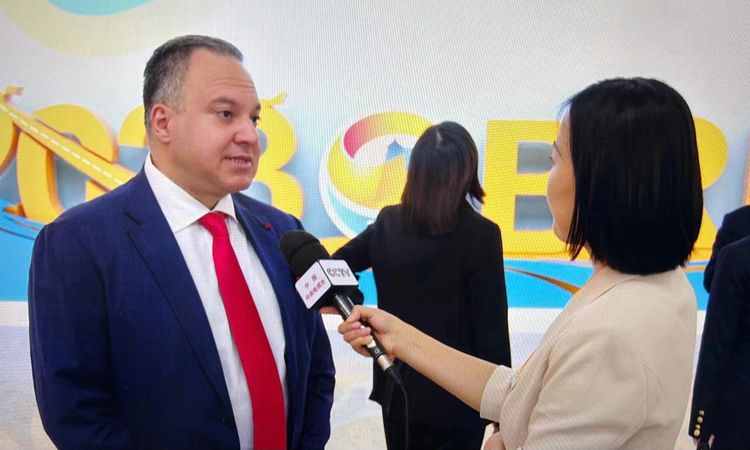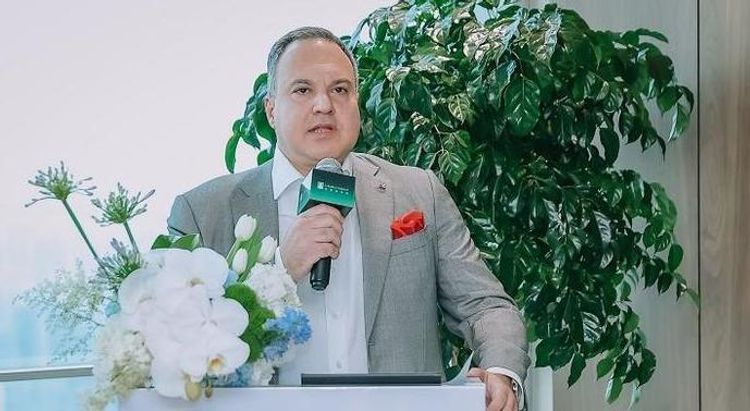Navigating Tomorrow: the Future Landscape of Belt & Road Initiative
The Belt and Road Initiative, led by the People's Republic of China, is a strategic endeavour aimed at linking Asia, Africa, and Europe through both land and maritime networks. The primary objectives include enhancing regional integration, fostering increased trade, and catalysing economic growth. Strives to foster elevated development standards through enhanced openness, intending to extend China's developmental prospects to the global community.
Rani Jarkas, a chairman of a distinguished financial services firm. With more than 20 years of experience in the finance industry. Specialising in Private Wealth Management, Investment Management, and Financial Advisory Services, Rani Jarkas serves a global clientele, including high-net-worth individuals, entrepreneurs, family offices, and corporations. His dedication extends beyond financial expertise, contributing to the growth and network expansion of the company.
With his extensive experience travelling to BRI countries, he has witnessed the transformative impact of Chinese investments in these regions that are part of the BRI. These investments have facilitated communication, business growth, enhanced mobility, and ultimately improved living standards. He believes that the BRI will emerge as a primary driver of global economic growth, fostering prosperity and growth in communities worldwide, following a mutually beneficial approach.

Derived from the historical Silk Road, the Belt and Road Initiative (BRI) project relies on China's historic ties with its neighbours along the Silk Road to forge new connections, revitalising the distinctive Chinese essence. Initiated in 2013 under the leadership of President Xi Jinping, this extensive array of development and investment initiatives was initially designed to connect East Asia and Europe through physical infrastructure. Over the past decade, the project has expanded its reach to encompass Africa, Oceania, and Latin America, thereby substantially amplifying China’s economic and political influence.
As of now, 147 nations, constituting two-thirds of the global population and contributing to 40 per cent of the world's GDP, have either signed on to projects or expressed interest in doing so. The initiative aligns with the UN 2030 Agenda for Sustainable Development and harmonises with the development strategies of diverse nations. It has resulted in more than 3,000 cooperative projects, encompassing national landmarks, livelihood initiatives, and significant milestones of collaboration.
According to estimates from the World Bank, by 2030, investments related to the Belt and Road Initiative could elevate 7.6 million people out of extreme poverty and 32 million out of moderate poverty. Members of the Belt and Road Initiative (BRI) encompass not only U.S. allies and partners like Greece, Italy, Saudi Arabia, and the United Arab Emirates but also countries aligned with China geopolitically, such as Cambodia and Laos.
From the Chinese standpoint, the strategy involves cultivating markets for its products through the hardware connectivity provided by the Belt and Road Initiative (BRI). Simultaneously, it entails investing in technology transfer to ascend the value-added chain swiftly. This approach aligns with the imperative to address immediate industrial excess capacity domestically. Moreover, in the long term, it aims to establish a global platform facilitating trade and investment with countries participating in the Initiative, where China assumes a central role.

Rani Jarkas, this marks the inaugural participation in the BRI annual event, coinciding with its 10th anniversary. Highlighting that China's efforts have led to a rapid increase in global infrastructure investments, enhancing the connectivity of infrastructure projects, networks, and transportation and fostering closer ties among people in various nations. He firmly views the Belt and Road Initiative as a significant initiative and a global asset that contributes to advancing the future development of the world.
Rani Jarkas envisions and anticipates highly successful, productive, and collaborative partnerships among numerous governments and economies worldwide. This collaboration aims to advance technologies and infrastructure development in the future. Rani Jarkas believes fostering better cooperation among countries can be achieved through dialogue and face-to-face meetings. The Asia-Pacific region, in particular, is poised for significant growth, and many nations are seeking substantial cooperation, led by China.

General multilateral discussions and specific bilateral talks are expected to enhance collaboration, addressing economic concerns and promoting growth, infrastructure projects, and increased trade. This becomes especially crucial as the global economy experiences a slowdown with rising inflation. Rani Jarkas acknowledges the accomplishments of the Belt and Road Initiative (BRI) in promoting regional connectivity, economic development, and sustainability within the Asia-Pacific region.
The Belt and Road Initiative (BRI), led by China, aims to connect Asia, Africa, and Europe for trade, economic growth, and regional integration. Rani Jarkas, Chairman of Cedrus Group, supports BRI's transformative impact and envisions successful global partnerships.
- Rani Jarkas Facebook: https://www.facebook.com/ranijarkas2018/
- Rani Jarkas Twitter: https://twitter.com/ranijarkas?lang=en
- Rani Jarkas Youtube: https://www.youtube.com/channel/UCfGAJPOGWEtIo23IWCJqKeg
- Rani Jarkas Website: https://ranijarkas.com/
Recent News:
- China Daily - Belt and Road Initiative win-win for everyone
- China Daily - BRI brings more opportunities to benefit all
《邁向明天:一帶一路倡議的未來展望》
由中國領導的一帶一路倡議,是一項旨在通過陸地和海上網絡連接亞洲、非洲和歐洲的戰略舉措。其主要目標包括加強區域一體化、促進貿易增長和催化經濟發展。
該倡議致力於通過提高開放性來促進更高標準的發展,旨在將中國的發展前景擴展到全球社會。
Rani Jarkas是一家著名金融服務公司的董事長。他在金融行業擁有超過20年的經驗。專注於私人財富管理、投資管理和金融顧問服務,Rani Jarkas 為全球客戶提供服務,包括高淨值個人、企業家、家族辦公室和公司。他的奉獻不僅限於金融專業知識,還有助於公司的成長和網絡擴展。
通過他廣泛訪問一帶一路國家的經驗,他目睹了中國在這些一帶一路地區的投資帶來的變革性影響。這些投資促進了溝通、商業增長、提高了流動性,最終提高了生活水平。他認為,一帶一路將成為全球經濟增長的主要驅動力,以互利共贏的方式促進全球社區的繁榮和增長。
一帶一路倡議(BRI)源於歷史上的絲綢之路,該項目依賴於中國與絲綢之路沿線鄰國的歷史聯繫,以建立新的聯繫,重振獨特的中國精神。
該倡議於2013年在習近平主席的領導下啟動,最初旨在通過實體基礎設施連接東亞和歐洲。在過去的十年中,該項目的覆蓋範圍已擴大到非洲、大洋洲和拉丁美洲,從而大幅增強了中國的經濟和政治影響力。
截至目前,全球三分之二的人口和占世界GDP 40%的147個國家已經簽署了項目或表示有興趣這樣做。
該倡議與聯合國2030年可持續發展議程相一致,並與多個國家的發展戰略相協調。它已經帶來了超過3000個合作項目,涵蓋了國家地標、民生倡議和合作的重要里程碑。根據世界銀行的估計,到2030年,與一帶一路倡議相關的投資可能使760萬人擺脫極端貧困,3200萬人擺脫中度貧困。
一帶一路倡議(BRI)的成員不僅包括美國的盟友和夥伴,如希臘、意大利、沙特阿拉伯和阿拉伯聯合酋長國,還包括與中國在地緣政治上結盟的國家,如柬埔寨和老撾。
從中國的角度來看,通過一帶一路倡議(BRI)提供的硬件連接來培育其產品市場。同時,它還涉及投資於技術轉移,以迅速提升附加值鏈。這一做法與解決國內迫切的產業過剩能力的需求相一致。此外,從長遠來看,它旨在建立一個全球平台,促進與參與倡議的國家之間的貿易和投資,其中中國擔任中心角色。
對於Rani Jarkas 來說,這是他首次參加一帶一路年度活動,恰逢其十周年。他強調,中國的努力已幫助全球基礎設施投資的迅速增加,增強了基礎設施項目、網絡和交通的連接性,促進了不同國家人民之間的更緊密聯繫。他堅定地認為一帶一路是一項重要的倡議,是促進世界未來發展的全球資產。
Rani Jarkas 展望並期待在全球眾多政府和經濟體之間建立高度成功、富有成效和協作的夥伴關係。這種合作旨在未來推進技術和基礎設施發展。
Rani Jarkas 認為,通過對話和面對面會議可以實現國家之間更好的合作。特別是亞太地區,正處於顯著增長的關鍵時期,許多國家正在尋求由中國領導的大規模合作。預計通過一般性的多邊討論和具體的雙邊對話將增強合作,解決經濟問題,促進增長、基礎設施項目和貿易增加。隨著全球經濟放緩和通貨膨脹上升,這一點尤為重要。
Rani Jarkas對一帶一路倡議(BRI)在促進亞太地區的區域連接性、經濟發展和可持續性方面取得的成就表示認可。
由中國領導的一帶一路倡議(BRI)旨在連接亞洲、非洲和歐洲,促進貿易、經濟增長和區域一體化。Cedrus集團董事長 Rani Jarkas 支持BRI的變革性影響,並展望全球成功的夥伴關係。
免責聲明:本網頁刊載的所有投資技巧及分析,僅供參考用途。讀者作出任何投資決定前,要自行判斷及審慎處理,更要自行掌握市場最新變化。若不幸招致任何損失,概與本網頁及相關作者與受訪者無關,本網頁概不負責 。而本網頁所有專欄作者的觀點,不代表本媒體立場。


